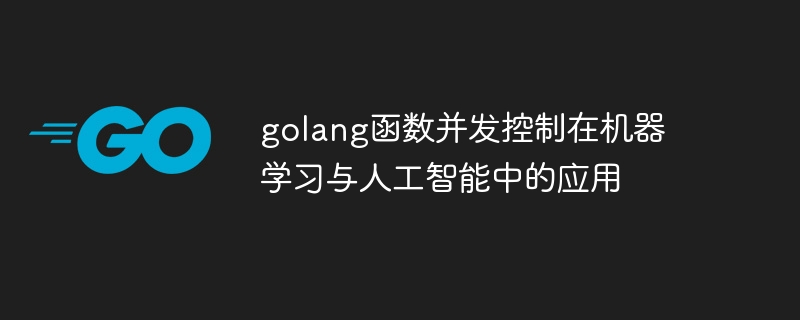
Concurrency control is implemented through goroutine, allowing Go code to execute tasks concurrently. In machine learning, concurrency can be used to speed up data processing, by executing operations such as training batches in parallel. In the field of artificial intelligence, concurrency is crucial, especially in applications that require processing large amounts of data in real time, such as image recognition and autonomous driving. The practical case shows using Go's TensorFlow library to implement image classification, taking advantage of concurrency to load batch image data and perform model inference.

The application of Go language function concurrency control in machine learning and artificial intelligence
Concurrency control is to develop high performance and scalable Key aspects of the code. Concurrency is especially important in machine learning and artificial intelligence (ML/AI) applications, which often require processing large amounts of data and computation.
What is concurrency control?
Concurrency control allows a program to perform multiple tasks at the same time. In Go language, this can be achieved through goroutines (lightweight threads). When you run a function in a goroutine, the function runs simultaneously with the rest of the application.
How to use Goroutine to achieve concurrency
Concurrent use of goroutine can be achieved in the following ways:
func myFunction() {
// 代码
}
// 创建一个 goroutine 来并发执行 myFunction
go myFunction()Concurrency in machine learning
Machine learning algorithms often require repeatedly performing computationally intensive operations. By using concurrency, these operations can be divided into different goroutines, significantly improving performance.
For example, when training a neural network, you can speed up the training process by executing multiple training batches simultaneously:
// 启动多个 goroutine 并行训练
for i := 0; i < numGoroutines; i++ {
go trainBatch(i)
}
// trainBatch 函数处理每个批次的训练
func trainBatch(batchNumber int) {
...
}Concurrency in Artificial Intelligence
In the field of artificial intelligence, concurrency is also crucial, especially in real-time applications. For example, in self-driving cars, data from different sensors needs to be processed simultaneously and real-time decisions need to be made.
The following is an example of using concurrency to process image recognition tasks in parallel:
// 并发处理图像识别
results := make(chan string, numImages)
for i := 0; i < numImages; i++ {
// 创建一个 goroutine 来处理每个图像
go func(imageIndex int) {
label := recognizeImage(imageIndex)
results <- label
}(i)
}
// 从频道读取识别的标签
for i := 0; i < numImages; i++ {
...
}Practical Case - Image Classification
Let’s create a simple Image classification model, using the TensorFlow library of Go language. We will use a trained ImageNet model to recognize images.
package main
import (
"context"
"fmt"
tf "github.com/tensorflow/tensorflow/go"
"github.com/tensorflow/tensorflow/go/core/resourcemanager"
"github.com/tensorflow/tensorflow/go/op"
"github.com/tensorflow/tensorflow/go/types"
)
func main() {
// 创建一个新的 TensorFlow 会话
sess, err := tf.NewSession(context.Background(), "local", nil)
if err != nil {
fmt.Println(err)
return
}
defer sess.Close()
// 准备输入图片
var imageData []byte
...
// 使用并发加载多批图像
numImages := 10 // 修改为实际图像数量
batchSize := 4
var blobs [][]byte
for i := 0; i < numImages; i += batchSize {
batch := imageData[i : i+batchSize]
blobs = append(blobs, batch)
}
// 创建 TensorFlow 图表
graph, err := op.NewGraph()
if err != nil {
fmt.Println(err)
return
}
placeholder := graph.Placeholder(types.Bool, op.WithName("input_tensors"))
inTypes := make([]*types.T, len(blobs))
for i, _ := range inTypes {
inTypes[i] = types.Bytes
}
enqueueOp := op.QueueEnqueue(placeholder).Inputs(inTypes)
ready, components, queueClose := op.QueueEnqueueMany(placeholder).Args(placeholder, placeholder).Attrs(map[string]interface{}{
"component_types": types.BytesList,
}).Output(0).Output(1).Output(2)
inTensor := op.BuildQueueDequeue(components, op.BuildQueueLen(components[2]), op.BuildQueueSize(components[2]), op.BuildQueueClosed(components[2]))
modelPath := "path/to/ImageNet_model" // 修改为实际模型路径
output, err := resourcemanager.LoadModel(modelPath, inTensor, graph)
if err != nil {
fmt.Println(err)
return
}
// 运行模型
for i, blob := range blobs {
// 并发执行
go func(i int, blob []byte) {
sess.Run(op.NewOperation(sess.Graph()).AddInput(placeholder, blob).MustSetAttr("component_type", types.String("string")).Output(enqueueOp),)
}(i, blob)
}
for {
readyArr, err := sess.Run(ready)
if err != nil {
fmt.Println(err)
break
}
// 处理结果
if readyArr.(bool) == true {
_, err = sess.Run(op.NewOperation(graph).AddInput(inTensor, 0).Output(output))
if err != nil {
fmt.Println(err)
}
} else {
break
}
}
// 处理剩余的图像
sess.Run(op.NewOperation(sess.Graph()).AddInput(placeholder, []byte(nil)).MustSetAttr("component_type", types.String("string")).Output(queueClose))
}Note: For the sake of brevity, the code omits error handling and completeness of TensorFlow session management. Be sure to include appropriate error handling in your production code.
The above is the detailed content of Application of golang function concurrency control in machine learning and artificial intelligence. For more information, please follow other related articles on the PHP Chinese website!




